Our annual analysis of chief executive pay in the largest academy chains once again reveals huge variations, including between men and women, and pay per pupil and school.
We looked at trusts with more than 20 schools in 2016-17. 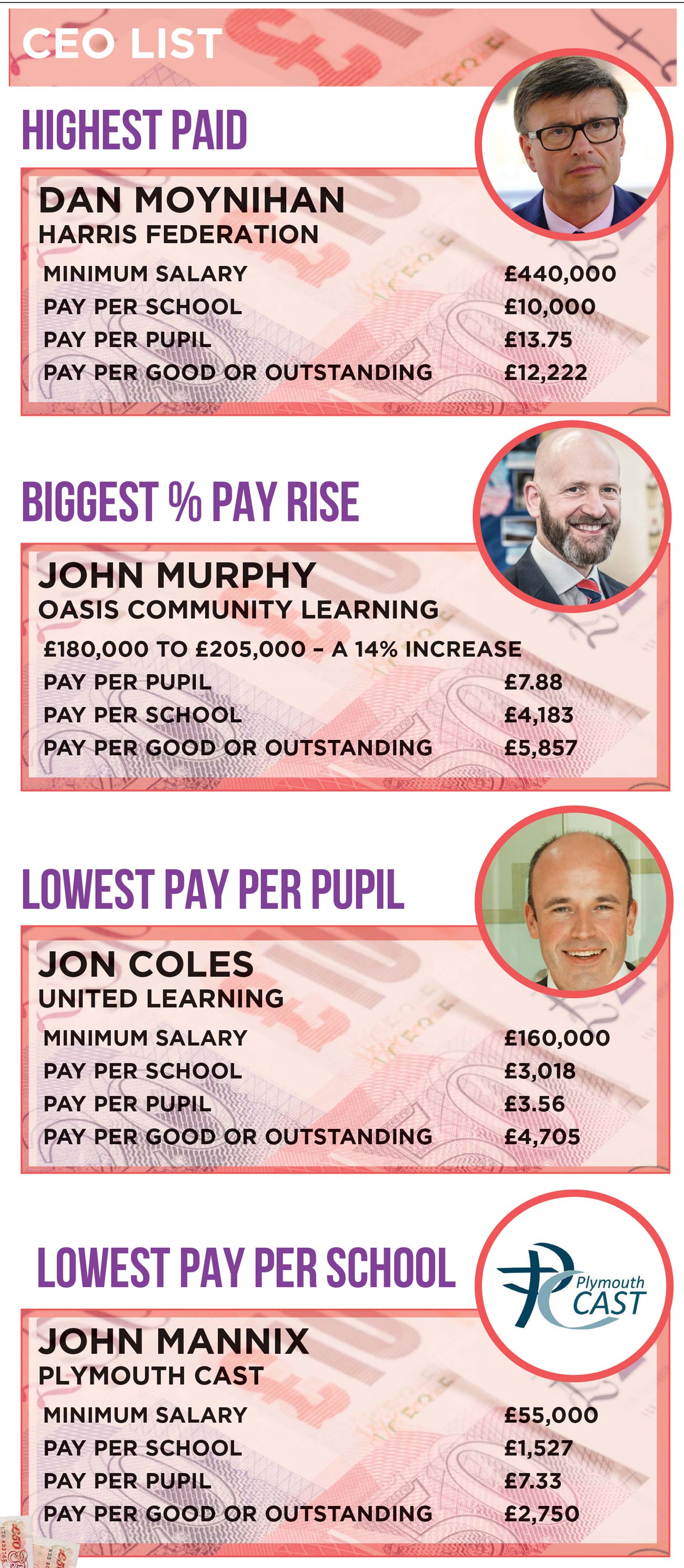
Sir Dan Moynihan of the Harris federation came top of all CEOs for salary, with a £20,000 pay increase to a minimum of £440,000 last year. However, the London-based boss earns almost half the amount per pupil compared with bosses in eight other trusts.
Harris took on four new schools last year, bringing Moynihan’s per pupil pay down from £16 last year to £13.75 this year. That’s significantly less than the £22 per pupil paid to Andrew Fielder at The Aspire academy trust in Cornwall.
However, Moynihan tops the list for pay per school. His salary equates to £10,000 for each of his 44 academies, more than treble that of Julian Drinkall, the new CEO of the country’s biggest chain, Academies Enterprise Trust. He gets £3,125 for each of its 64 schools. Meanwhile Paul Tarn gets £4,186 for each of the schools in Delta academies trust.
Moynihan is also not the highest paid for every good or outstanding school: he comes fourth with £12,222 for each of Harris’ 36 good or better rated schools.
Only three of Astrea trust’s 23 schools have been inspected. Two are good, placing Libby Nicholas top for pay per good or outstanding school.
The former CEO at Plymouth Cast, John Mannix, earned the least at £2,750 for each of its 20 (of 36) schools graded good or better. Drinkall gets about £4,000 for each of the 49 (of 64) schools graded good or better.
Pay rises across the sector
Two-thirds of the chief executives of 24 trusts with more than 20 schools got a pay rise. However three diocesan trusts – Peterborough, Ely and Oxford – could not share the information within the timeframe, while a spokesperson for the Academy Transformation Trust, whose accounts were not available at publication, could not provide any information.
The rise comes as teachers’ pay lifts remain capped at 1 per cent.
Together the trusts handed out £118,000 more than in 2015-16 – from £3.9 to £4 million – to their leaders.
Leadership should be a support function for what happens in classrooms, but it often feels the other way around
Mark Wright, director of ATL’s leadership section at the National Education Union, said the rewards were “disproportionate”, pointing to research by the Centre for Education Economics in 2016 that said no evidence clearly linked leadership with pupil outcomes.
“Leadership should be a support function for what happens in classrooms,” he said. “But it often feels the other way around – teachers feel they are supporting senior leadership teams and their demands.”
Trustees should stop using the corporate world as their benchmark for salaries, he said.
The highest boost went to John Murphy at Oasis Community Learning, with a £25,000 rise, followed by Moynihan and Toby Salt (now replaced by Nick Hudson) at Ormiston academies trust with £20,000, Diana Owen at LEAD academy trust and Gary Peile at the Active Learning trust with £11,000.
But four trusts cut CEO salaries: Mannix at Plymouth Cast, Drinkall who replaced Ian Comfort at AET, Martyn Oliver at Outwood Grange academies trust, who has replaced Sir Michael Wilkins, and Rowena Hackwood at the David Ross Education Trust, who has replaced Wendy Marshall. Their salaries fell, evidently because they are new to their roles.
Three leaders stayed on the same salary, although in all cases they took on more responsibility: Jon Coles at United Learning stayed at £160,000 but acquired eight more schools; Wayne Norrie stayed at £170,000 at Greenwood Academies trust but took on two special schools and Libby Nicholas at Astrea academy trust stayed at £130,000 but took on six new schools.
This compares with five trusts that upped CEO pay without adding more schools: Reach2, E-ACT, the Kent Catholic Schools Partnership, the Enquire Learning Trust and Delta.
Hugh Greenway at the Elliot Foundation moved from £165,000 to £166,650 last year, a 1 per cent rise, while its teachers got a 2 per cent boost.
Mind the gender gap
Schools Week has worked out the average CEO pay for men and women.
Seven women lead the 24 trusts in the country with 20 or more schools, for which full data is available. Two Church of England trusts also have women at the top – Anne Davey at the Oxford Diocesan Schools trust, and Sarah Conant at the Diocese of Ely MAT, but their salaries are paid by the diocese and not the trust. The dioceses refused to release this information.

For the top 10 trusts with the most schools, only three have female bosses: Dr Karen Roberts at The Kemnal Academies Trust, with 43 schools, Lucy Heller at ARK with 36 schools (half of whose salary is paid by Ark’s parent charity) and Dr Karen Cook at Plymouth Cast with 36 schools. Cook will be replaced in July by Raymond Friel, currently head of the Catholic Independent Schools’ Conference.
Heller is in the top 10 for best-paid CEOs, as are Hackwood at David Ross and Diana Owen at the LEAD multi-academy trust.
Schools Week has calculated that across the 16 trusts headed by men with 20 or more schools, the average CEO salary was £174,765. Across those headed by women, the average salary was £139,800 – almost £35,000 less.
Women are also heading trusts that have slightly fewer schools: 32 on average, while men lead trusts with 36 schools on average.
Vivienne Porritt, the co-founder of WomenEd, said the data was yet another example of a “rampant” gender pay gap in education that was becoming “really tiring.”
“Are trustees, who are also mostly male, appointing people who look and think as they do?” She also called on large academy trusts to “get cracking” and publish their gender pay gaps before next month.
Keziah Featherstone, another co-founder of WomenEd, said male chief executives should not negotiate salaries to “see what they could get away with” and more women needed to be placed in headship roles so they could head towards the top role.
Schools Week exclusively reveals 2017-18 pay
We can reveal the pay of 11 CEOs ahead of the 2017-18 accounts (see table below).
Just four are not taking a pay rise, including Martyn Oliver at Outwood Grange academies trust and Gary Peile at Active Learning.
Of those, two haven’t had a rise for three years running: Wayne Norrie at Greenwood Academies Trust and Jon Coles at United Learning.
Rowena Hackwood at David Ross is on nearly £30,000 less than her (female) predecessor, while David Moran’s salary at E-ACT has only inched up by about £500 over three years. Julian Drinkall at AET joined the organisation part way through 2016-17 and waived a salary increase for 2017-18.
*A reference to Paul Tarn’s salary at Delta was removed after the trust said the 2015-16 salary they provided was only part-time.



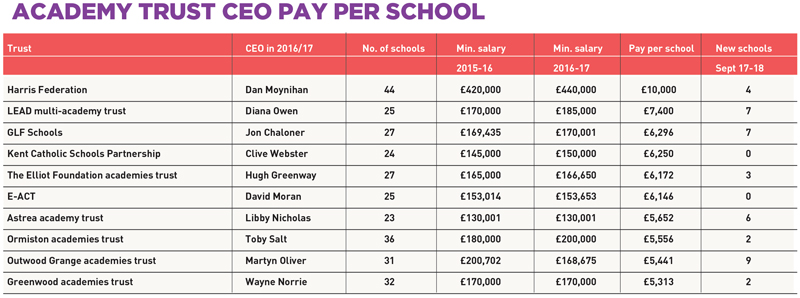
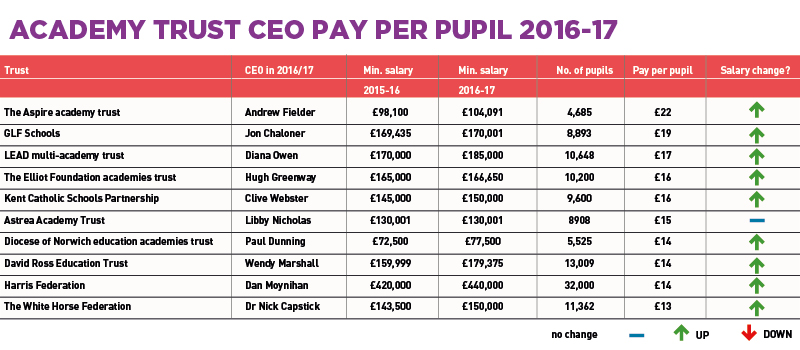
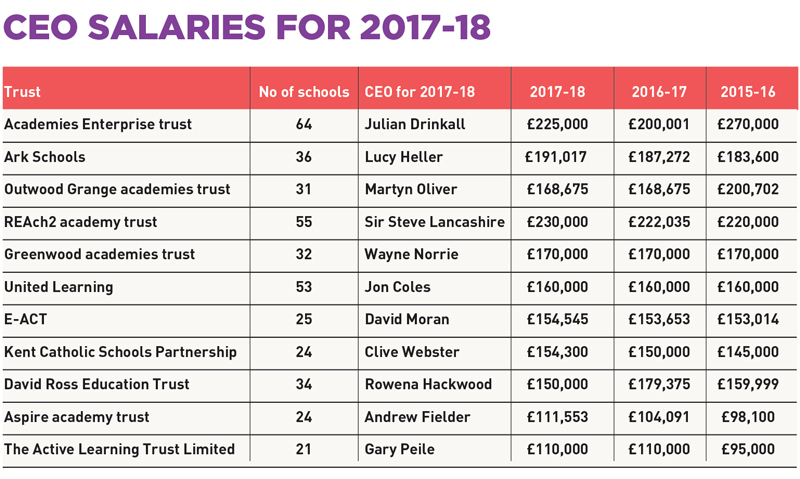



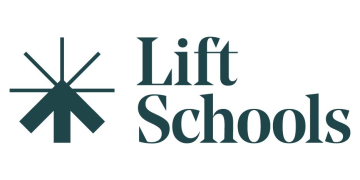

Whilst the exposure of CEOs being paid too much money is always a good thing, the amount of mistakes in this “analysis” is shocking.
Before getting onto the mistakes, why is Schools Week suddenly limiting its focus on those CEOs of MATs with more than 20 schools? A couple of weeks ago there was a piece on how the Transforming Lives Education Trust was paying its CEO £270,000. There are two schools in that MAT, one of which is an infants school with 179 pupils. According to those figures the CEO is paid £135,000 per school and about £138 per pupil. That seems rather more worrying and in need of in depth investigation.
But onto the specifics of the piece above. Given that all the information is in the public domain I had a quick look.
The first point to note is that the columns marked “min salary” actually should be marked “max salary”. As with all individuals within MATs, the pay for CEO is shown in a banding (e.g. £100,000 – £105,000). The figures in the table are the top of these ranges, hence they are the maximum amount the CEO was paid.
Picking a MAT at random I looked at the 2016/17 accounts (published on the Companies House website) for L.E.A.D. multi academy trust (second in the ‘pay per school’ table). According to the table the CEO was paid £185k in 2016/17 for running 25 schools which equates to £7,400 per school. The only problem with this is that in 2016/17 there were 20 schools in this MAT (they have 25 schools today, but not in the year the table is analysing). So actually he was paid £9,250 per school – that’s a 25% discrepancy from the figures provided by Schools Week.
Did Schools Week analyse all the MATs by looking at the 2016/17 salary and comparing it to the number of schools as at March 2017?
Was the analysis of pupils number similarly flawed by using pupil numbers as at March 2017?
It’s listed Astrea academy trust as having 23 schools – however according to both Astrea’s website and the DfE there are only 20 schools currently in that MAT with another one due to open in September 2018. Where does 23 come from?
It says the Ely Diocesan MAT refused to release CEO pay – 30 seconds online at Companies House shows that the CEO for the relevant 2016/17 period was Andrew Read (not Sarah Conant who Schools Week says leads the MAT – she is the Chief Operating Officer) and he was paid £55,000-60,000.
Finally it should be blindly obvious to anyone that you can’t “reveal the pay of CEOs ahead of the 2017-18 accounts”. The 2017-18 accounts cover the period up to 31 August 2018 – over 5 months away. CEOs might resign or be fired, have salaries increased/decreased, be given bonuses or not. I’m guessing that what is published are the EXPECTED levels of remuneration of CEOs, but this should have been made clear.
This is a serious area and Schools Week rightly tries to shine a light onto what happens and what is happening to public money. However if it’s taken me 10 minutes to look at the facts and see there are fundamental mistakes into how this is being presented then it’s just not worth the paper.
Mark – it seems you and I are covering some of the same ground (although I haven’t gone into such depth).
However, I can’t find the info in the accounts of Diocese of Ely MAT that CEO Andrew Read was paid £55k-60k. There were five members of staff paid between £60k and £70k and 2 paid between £70k and 80k. But none were named. It’s likely the CEO would be paid at the highest rate but we can’t be sure.
I took rather longer than you, I’m afraid. 30 seconds! It took me at least 20 times that! And I was still left scratching my head.
Mark – further to the above. I’ve discovered Andrew Read is a member, a trustee and part of the senior leadership team of Ely MAT. The Academies Handbook 2017 says employees of a trust mustn’t be members. It would appear that Ely MAT isn’t following DfE rules.
Whilst I completely agree that it is NOT a good idea for any individual to be a Member, Trustee and SLT member, the Financial Handbook does not absolutely prohibit it. What is says is that “Employees of the trust must not be appointed as members unless permitted by their articles of association.”
The current model articles state clearly that “An employee of the Academy Trust cannot be a Member of the Academy Trust”, however that term is not included in DEMAT’s Articles, and whilst not referring to employees specifically those Articles do permit them to be appointed as Members.
On that basis DEMAT is not following best practice or DfE guidance, but I don’t think it can be said they’re breaking rules.
Thanks, Mark. You’ve exposed another loophole.
The accounts for DEMAT can be downloaded from https://beta.companieshouse.gov.uk/company/08464996/filing-history
Andrew Read’s salary is detailed on page 37
Thanks – I got no further than ‘Staff costs’ on page 35 – my head was spinning by then. Interesting that there are staff members paid more than him. Or (this is tongue in cheek) – could someone receive payment for employment AND payment for trustee work?
The answer to that is no – you can’t get paid for Trustee work. Presuming the accounts are correct, the absolute maximum Andrew Read received from DEMAT was £60,000.
However, that doesn’t mean he didn’t also receive money from the Diocese, independently of DEMAT. This is an approach which is sometimes used when an organisation sponsors a MAT – the CEO will receive some money from the Sponsor and some from the MAT.
For example a University sponsors a MAT, and the Chief Executive of the University is also the CEO of the MAT. She might split her time 2 days a week on University work, 3 days a week on MAT work – so the MAT would only pay 3/5 of her annual salary.
Alternatively, the CEO might work full time for the MAT but as the Sponsor I cover 75% of their salary as part of my financial contribution to the MAT.
The accounts only show what the CEO receives from the MAT (and any subsidiary companies or through related party transactions etc.).
Last year, when discussing the review of pay, the Editor said that in addition to academy trust pay Schools Week would be addressing highly-paid heads of maintained schools.
Can we take it this approach has been entirely abandoned now?
The most extraordinary omissions here are the two largest MATs in the country – AET and Reach2.
Schools Week’s only reference to AET is that the new CEO is payed less than the old CEO. According to the 2016/17 accounts, the combined pay for both CEOs was £405,000 covering 63 schools. That’s £6,429 per school which would be 3rd in the ‘pay per school’ table.
Schools Week only reference to Reach2 is that they upped CEO pay without adding more schools. According to the 2016/17 accounts, their CEO was paid £250,000 in relation to 16,665 children. That’s £15 per pupil which would put him 7th in the ‘pay per pupil’ table.
I also looked at the Flying High Trust (which now has 20 academies), purely because I liked the name. Their CEO was paid up to £115,000 covering 5,355 pupils – £21 per pupil. That would be 3rd in the ‘pay per pupil’ table.
Have to say I don’t think there’s any point in looking any further. This so-called analysis is obviously hopelessly inaccurate and incomplete. It’s a serious and important issue and someone should do a proper job of analysing and reporting on it – maybe one of the accountancy firms Schools Week are raving about today.